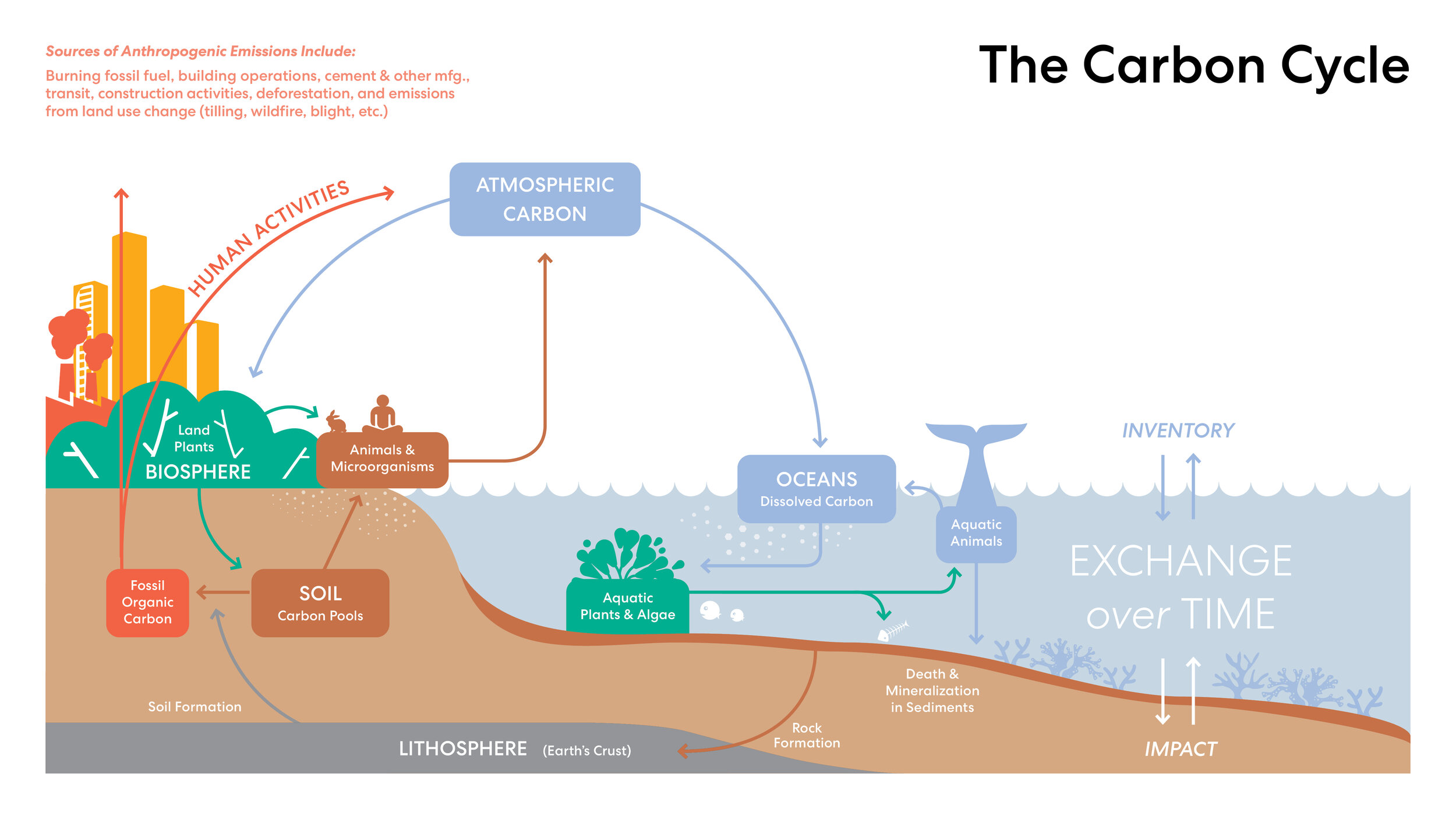Carbon Cycle & Timber
The context of the carbon cycle.
The carbon cycle illustrates an inventory of the location of carbon dioxide (CO2) within our planet’s carbon pools. The impact of removing CO2 from the atmosphere relates to exchange and time.
Inventory & exchange.
Forests sequester and store carbon, cycling it from atmosphere to biosphere to soil carbon and back. Land use change and poor management practices break this cycle. Best management practices and market demand can support it.
Impact over time.
Longevity of use, opportunity for reuse, and mindful end-of-life are essential factors for maintaining and increasing storage of carbon in timber products. The longer a unit of carbon is stored, the better. Some sources call for each “offset” unit to be stored for at least 100 years to be considered a complete negative emission.
New to the carbon conversation?
Click here to view a glossary of terms
Humans’ relationship to this ecosystem is at least as old as humanity. Over time we have come to understand the forest as a source of protection, heat, nourishment, identity, inspiration, product, and profit alike. Timber production is intrinsically bound to the forest ecosystem. The forest’s “natural” cycle represents a closed loop: diverse, evolving, growing, decaying, and perpetually providing our planet with life.
Supply chain is the system by which trees become mass timber. This system is often understood in terms of inputs and outputs, or products. Yet timber is more than a product; it is the only primary structural material approved by the International Building Code that is derived from a living, carbon sequestering resource.
Best management practices and demand for sustainable timber can decrease risk of disturbance and contribute to stabilization or growth of forest stocks.
Well-managed forests can protect against land use change - which is important, because most of forest carbon stocks are actually in the soil, and agriculture, deforestation, wildfire, and other land-use change is the second-largest contributor to anthropogenic emissions after use of fossil fuel.
While it is best to extend the use of timber as long as possible, the US EPA assesses that even land-filled timber retains over 80% of its carbon in the soil. Certified timber with an end-of-life plan (other than incineration) will likely store more carbon that was required in production.
Net-neutral carbon impacts of timber
According to ISO 21930, Life Cycle Assessment can be used to account for the carbon storage benefits of timber in a project if its wood comes from either:
Certified forests or mills
(CSA, FSC, SFI, or PEFC)
Certifications such as FSC, SFI, PEFC, CSA, or ATFS can provide teams with a base level of assurance that a given timber buyout is tied to forest management or fiber sourcing practices that come from legally harvestable sources. Certification also makes it more likely that the land where the timber was harvested from will continue to be maintained as forest land, providing carbon sequestration and other ecosystem services.
A region with stable or increasing forest carbon stocks
Stability of forest stocks can be based on United Nations Framework Convention on Climate Change (UNFCCC) national inventory reporting. In the US and Canada, the net carbon flux from forestry is currently stable and sometimes shows net removal, or sequestration of carbon. However, this is not the case everywhere. If a team insists on procuring timber from a part of the world where carbon stocks are decreasing, which is the case in much of the global South, that timber must be certified.
Beyond attaining carbon neutrality, timber can store more carbon than is required in production, making it a "drawdown" material. While product-specific EPDs for timber are still evolving, some groups, like FSC, are trying to demonstrate that high standards in forestry practices can result in more carbon storage (or "Drawdown" potential) than others.
Despite the clear potential benefits of timber - carbon stored in timber does not simply negate current emissions that the project has produced. Our studies of the project’s carbon impacts align with ISO (net carbon neutral), and we encourage teams to think about any additional carbon that may be stored in sustainable timber as a bond or an asset that follows the life cycle of that timber.
Our approach to reducing carbon impacts breaks out reduction from sequestration:
Reduce: Minimize emissions associated with extraction, transport, manufacturing, installation, and use impacts.
Sequester: Support maximum forest health and sequestration, acknowledge that timber has carbon stored in it, and establish a plan for the owner to hold this carbon as an asset and pass it on.
Despite obvious potential benefits of timber, it is important to recognize that the idea of offsetting or drawing down carbon is complex and multi-scalar. Sometimes the most regenerative option does not equal greater carbon reduction at a site-scale. E.g., Actions like maintaining smaller, trees around a riparian zone to support habitat, protecting senescent old growth forest, or retaining grasslands may not maximize carbon reduction on a given site. We can keep this in mind as we design, working with alternative approaches like reclaimed wood, bio-diverse species, coppicing, prefabrication, and certification systems that address greater ecological impacts. Together, we can design built environments that engage the value of living systems.







